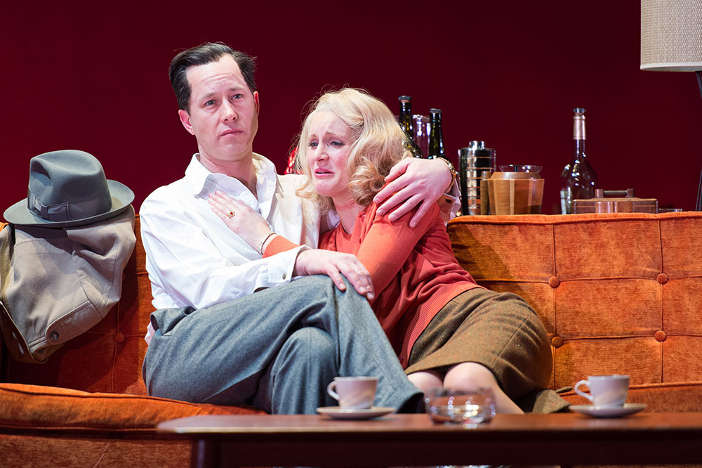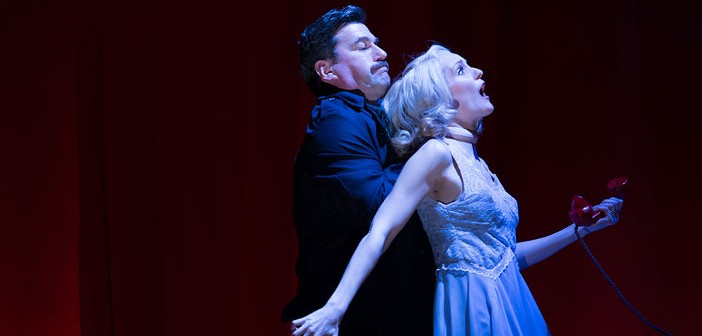Directed by Lucy Bailey, this production of Dial M for Murder relies heavily on the acclaimed Alfred Hithcock 1954 film version starring Ray Milland and Grace Kelly, rated ninth in the American Film Institute’s ‘Top Ten’ mystery film genre poll. Telling the story of a former tennis star who plots to murder his wife, the fact that it was originally conceived by Frederick Knott as a stage play makes it a natural choice for a revival and it’s only surprising that we’ve been waiting so long.
The action initially moves at a good pace and I thought I was settling down to watch something special. Tony Wendice (Daniel Betts), now retired from tennis and making a paltry living selling sports equipment, cries off from a night out with his wife Sheila (Kelly Hotten) and her old flame Max Halliday (Philip Cairns) who has just returned from living in New York. Whilst it initially seems odd that he would be happy for the pair to be together alone, Tony, so it transpires, has other plans. Having looked up C. A. Swann from his old school on the pretence of buying his car, he doesn’t waste time in commissioning him to murder his wife. Nor does the shady Swann take much persuading after Tony explains the seemingly watertight story. The murder will take place tomorrow.

Daniel Betts as the devious Tony delivers the strongest performance of an otherwise weak cast and gives his counterpart Ray Milland a fair run for his money. Cairns on the other hand is disappointingly flat, as is the kiss he shares with Sheila in the first act. Where is the chemistry I ask myself? Hotten as Sheila is passable without setting the world on fire, but then Grace Kelly is a hard act to follow. Admittedly, her lengthy struggle with Swann is enjoyable to watch, even if you are rooting for him to succeed in strangling her. The play continues with Sheila heading for the gallows much to her husband’s joy and Christopher Timothy makes a convincing Inspector Hubbard who suspects that all is not what it seems.
Mike Britton’s set is perhaps the only redeeming feature; sleek Fifties, with a bold red design which revolves in slow motion to provide the audience with different angles and perspectives of the Wendices’ Maida Vale flat where the action takes place. Unlike so many drawing room who-dunnits, the suspense doesn’t focus on who the murderer might be, but lets us in on the secret and then forces us to watch. With a director whom we know can achieve so much, this production feels lazy and lacklustre. As a result of relying on the film too much, this Dial M for Murder lacks any identity of its own and the attempt to impersonate Hitchcock’s inimitable style feels amateurish. It’s not all down to Bailey however, it’s just possible that this production would have worked if the cast had possessed an ounce of charisma. As it is, Hitch is having the last laugh and his reputation as ‘The Master of Suspense’ remains conspicuously unchallenged.
Dial M for Murder on a UK tour until Saturday 28th June 2014. For more information and tickets visit the website.




